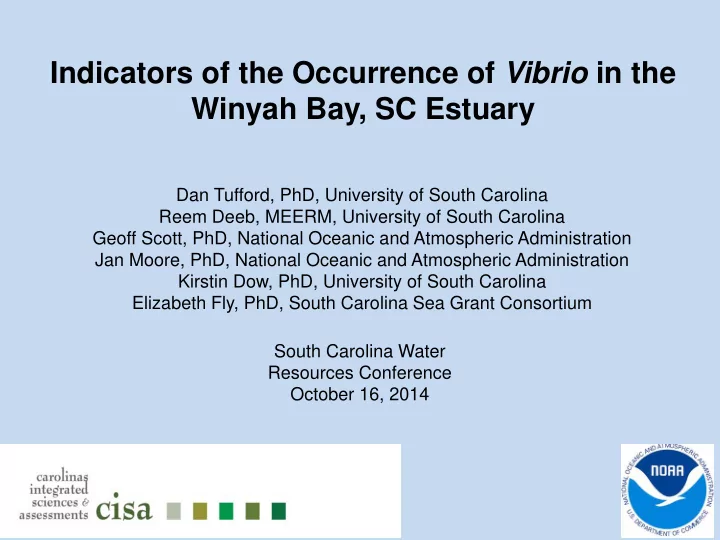

Indicators of the Occurrence of Vibrio in the Winyah Bay, SC Estuary Dan Tufford, PhD, University of South Carolina Reem Deeb, MEERM, University of South Carolina Geoff Scott, PhD, National Oceanic and Atmospheric Administration Jan Moore, PhD, National Oceanic and Atmospheric Administration Kirstin Dow, PhD, University of South Carolina Elizabeth Fly, PhD, South Carolina Sea Grant Consortium South Carolina Water Resources Conference October 16, 2014
Acknowledgements National Oceanic and Atmospheric Administration (NOAA) -- Center for Coastal Environmental Health and Biomolecular Research (CCEHBR), Charleston, SC Special thanks to the field team and laboratory for excellent support in planning and executing this project.
Concept Field sampling PRISM2 for Vibrio model This project Prior project Forecast future Vibrio in the study area This project 3
Research Objectives • Quantifying the distribution of Vibrio vulnificus and Vibrio parahaemolyticus in the Waccamaw River/Winyah Bay estuary • Correlate Vibrio occurrence with environmental parameters – Especially salinity / conductivity • Potential trends of Vibrio for the years 2055- 2068 under future sea level and streamflow
Methods • Monthly sampling in the Waccamaw River/Winyah Bay – Surface/bottom water – Field parameters measured – April – October 2012 – Special Sandy sample Filter and incubate • – CHROMagar – Focus on V. vulnificus and V. parahaemolyticus • Statistics – Correlations of Vibrio spp with temperature, conductivity, and turbidity – Regression models • Couple with PRISM2
Methods • PRISM2 overview – Developed by USGS and ADMi – Neural network model – Uses streamflow, sea level, and tide stage – Predict conductivity in the Waccamaw River and Intracoastal Waterway • PRISM2 – Trained using historic data – HSPF model predictions of future streamflow Used 1, 2, 3 ft. sea level rise – Predict future conductivity – • This project – Predict impact on Vibrio distribution
Results • Vibrio found at all sites – Highest concentrations within known optimal salinity range • PRISM2 predicts conductivity increases – Sea level is stronger driver of salinity trends than river flow 90 th percentile conductivities 2X – 15X – depending on location and SLR – Peaks more frequent and longer duration • V. vulnificus – More common in upriver sites – High concentrations more frequent and longer duration – Depends on SLR
Implications • Greater opportunity for exposure – Geographic range increase – Temporal expansion Exposure risk based on occurrence of • optimal conductivity range Increase as much as 36X – – Wound infections only • Other factors Temperature not included in this study – Optimal range is 15-30 o C –> V. vulnificus – Estuarine water is warming – Expect more days per year in range –
Summary and conclusions 1) Vibrio spp. occur throughout the Waccamaw River/Winyah Bay estuary 1) Even fresh water reaches 2) Salinity predicted to rise in the future 1) Higher salinities, greater frequency, and longer duration of conditions that favor Vibrio growth 3) Potentially significant public health implications 4) Future work: 1) Look at virulence 2) Integrate temperature into the model
Questions? PRISM2 report Conrads, P.A., Roehl, E.A., Jr., Daamen, R.C., and Cook, J.B., 2013. Simulation of salinity intrusion along the Georgia and South Carolina coasts using climate-change scenarios: U.S. Geological Survey Scientific Investigations Report 2013–5036, 92 p. + 5 apps. (http://pubs.usgs.gov/sir/2013/5036/) Deeb thesis Deeb, Reem, 2013. Climate Change Effects on Vibrio Bacteria in the Winyah Bay Estuary and the Projected Spread of Vibrio Under Future Climate Scenarios. Masters thesis, University of South Carolina, Columbia. 106 p. 10
Recommend
More recommend